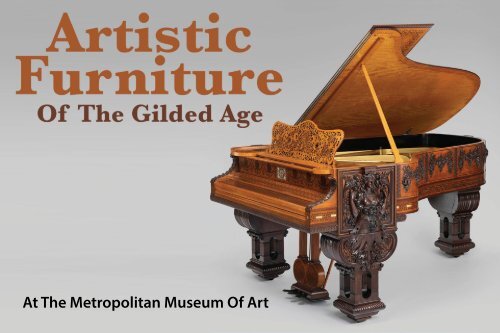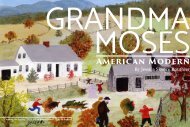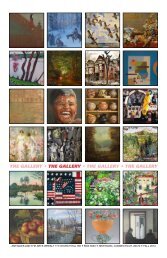At The Metropolitan Museum Of Art
Furniture
Furniture
You also want an ePaper? Increase the reach of your titles
YUMPU automatically turns print PDFs into web optimized ePapers that Google loves.
<strong>At</strong> <strong>The</strong> <strong>Metropolitan</strong> <strong>Museum</strong> <strong>Of</strong> <strong>Art</strong>
By Kate Eagen Johnson<br />
NEW YORK CITY — “This commission marks Arabella<br />
Worsham’s moment of transformation as she establishes<br />
herself as a woman of taste.” Excited in the telling, Alice<br />
Cooney Frelinghuysen underscored the significance of<br />
Worsham’s selection of George A. Schastey to reimagine<br />
her Manhattan mansion as an Aesthetic-style showplace<br />
in 1881. This event is central to the three-part exhibition<br />
“<strong>Art</strong>istic Furniture of the Gilded Age,” which opened at<br />
the <strong>Metropolitan</strong> <strong>Museum</strong> of <strong>Art</strong> on December 15. <strong>The</strong><br />
Page Above: <strong>The</strong> exhibition’s programmatic offerings include concerts of Gilded Age music<br />
performed on this “attribution benchmark object” made for William Clark of Newark, N.J. Model<br />
B grand piano with case by George A. Schastey & Co. and piano by Steinway & Sons, New York<br />
City, 1882. Satinwood, purpleheart, brass and silver mounts. Collection of Paul Manganaro.<br />
Right: <strong>At</strong> the same time Schastey was redecorating her home, Worsham had this portrait made<br />
while touring Europe. “Mrs Arabella Worsham” by Alexandre Cabanel (1823–1889), Paris, 1882.<br />
Oil on canvas. Fine <strong>Art</strong>s <strong>Museum</strong>s of San Francisco, gift of Archer M. Huntington.
concept of “transformation” runs as a leit motif<br />
with relevance to the patron, the cabinetmakerdecorator<br />
and others involved with these luxurious<br />
furnishings and even to certain of these interiors<br />
themselves.<br />
Not the least of those transformed is George A.<br />
Schastey (1839–1894), whose artistic reputation<br />
has risen exponentially. Having fallen into<br />
obscurity until resurrected through this initiative,<br />
Schastey has now assumed a place in the<br />
pantheon of American Aestheticism alongside<br />
Herter Brothers and Pottier & Stymus.<br />
“Morning” by John La Farge (1835–1910), New York City, circa 1881.<br />
Opalescent glass and painted decoration. This window and its companion,<br />
“Evening,” were originally part of the 4 West 54th Street mansion. Worsham’s<br />
son, Archer M. Huntington, created Audubon Terrace in upper Manhattan.<br />
<strong>The</strong> Academy of <strong>Art</strong>s and Letters and <strong>The</strong> Hispanic Society of America are still<br />
a part of that cultural center. American Academy of <strong>Art</strong>s and Letters.
<strong>The</strong> three-part<br />
exhibition<br />
“<strong>Art</strong>istic Furniture<br />
of the Gilded<br />
Age” celebrates<br />
the recent<br />
metamorphosis<br />
of the Worsham-<br />
Rockefeller Dressing<br />
Room, designed<br />
and executed by<br />
George A. Schastey<br />
& Co., New York<br />
City, 1881–82.<br />
<strong>The</strong> <strong>Metropolitan</strong><br />
<strong>Museum</strong> of <strong>Art</strong>, gift<br />
of the <strong>Museum</strong> of<br />
the City of New York.
Frelinghuysen, the Anthony W. and Lulu C. Wang<br />
curator of American decorative arts, and Nicholas<br />
C. Vincent, manager of collections planning — with<br />
support from research assistant Moira Gallagher —<br />
co-curated this dazzling exhibition. Its centerpiece is<br />
the newly installed and conserved Worsham-Rockefeller<br />
Dressing Room, originally part of Schastey’s interior<br />
design campaign for the 4 West 54th Street mansion.<br />
Miraculously squeezed into a redundant stairwell, the<br />
dressing room joins the chronologically arranged period<br />
rooms on permanent display in the American Wing.<br />
It stands as testament to the project team’s research,<br />
conservation and restoration accomplishments.<br />
<strong>The</strong> Worsham mansion a tawdry love nest? Hardly! Yet suggestive of an atmosphere of<br />
amour is the glistening mother-of-pearl inlay “mistletoe” ornamenting the dressing<br />
glass. Dressing table and dressing glass, Worsham-Rockefeller Dressing Room, George A.<br />
Schastey & Co., New York City, 1881–82. <strong>Metropolitan</strong> <strong>Museum</strong> of <strong>Art</strong>, gift of the <strong>Museum</strong><br />
of the City of New York.
Richly ornamented in satinwood, purpleheart<br />
(amaranth), mother-of-pearl and silver and gold<br />
leaf, the intimate Worsham-Rockefeller Dressing<br />
Room absorbs only 12 by 18 feet of floor space.<br />
As Frelinghuysen noted, the form of the room<br />
was inspired by an Italian Renaissance studiolo,<br />
or scholar’s study. <strong>The</strong>re is seriousness in the<br />
Renaissance- and Mannerist-inspired carving<br />
and marquetry on cabinetry doors and drawers.<br />
In counterpoint, on the door frames feminine<br />
accoutrements, including a hand mirror, comb,<br />
scissors, an étui and various pieces of jewelry, are<br />
rendered as marquetried trophies highlighted by<br />
mother-of-pearl insets. One can imagine putti<br />
A remarkable object on many counts, Schastey’s miniature “Barcalounger”<br />
maintains its original 1870s silk upholstery. Patent model for adjustable<br />
reclining chairs by George A. Schastey, New York City, 1873. Walnut, silk and<br />
paper tag with ink. <strong>Metropolitan</strong> <strong>Museum</strong> of <strong>Art</strong>, New York, gift of Mr and Mrs<br />
John Schorsch.
flying off the room’s painted canvas frieze and<br />
plucking the dainty tools and personal ornaments<br />
from the door frames in rococo-winged flurry to<br />
assist Worsham at her toilet.<br />
Until May 1, this prize historic interior will<br />
be set off by two companion gallery exhibitions<br />
featuring more than three dozen gems of<br />
American Aesthetic design. <strong>The</strong> first spotlights<br />
the furnishings Schastey’s firm executed for other<br />
rooms in the Worsham mansion and for the other<br />
projects. Nearly all of these tour-de-force...<br />
(Continued on page 30 inside the E-Edition)<br />
Frelinghuysen told how historian Shelley M. Bennett discovered an album of<br />
photographs of Worsham’s mansion at the Hispanic Society of America. This<br />
case piece appears in a photograph of the drawing room. Cabinet by George<br />
A. Schastey & Co., New York City, 1881–82. Ebonized oak, brass, gilded bronze<br />
and agate. Seattle <strong>Art</strong> <strong>Museum</strong>.<br />
Read Full <strong>Art</strong>icle<br />
on Desktop<br />
Read Full <strong>Art</strong>icle<br />
on Mobile
Browse More<br />
From Windsor To Waikiki<br />
<strong>At</strong> Nadeau’s<br />
New Year’s Day Sale<br />
It’s Standing Room Only<br />
As Copake Auction<br />
Rings In New Year<br />
Birchwood Manor<br />
New Year’s Show<br />
Dazzles Collectors







